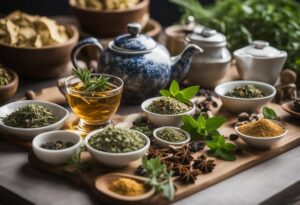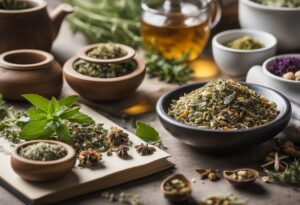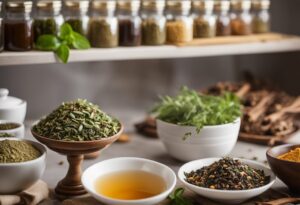==================
A Caveat and Affiliates
First off, a little caveat: within my articles you will find affiliate links, meaning if you buy them, I get a small commission. Your cost is not affected. In addition, I am an Amazon Associate and I earn from qualifying purchases on Amazon.
And yes, if I say that I recommend a product here, it means I truly believe it is a good product. I refuse to recommend any product that I have not researched and believe to be a good value.
Even better, I provide you with a very clear picture of the product, it’s use, and the probable value.
Earning your trust is important to me. I run this website myself and the commissions and donations help support the site.
Sound reasonable and fair enough? Let’s continue to the article.
==================
Contents
Tea And Conservation: Protecting The Ecosystem
Ever sip your tea and wonder about the journey those leaves took to reach your cup? For many tea lovers, the focus might be on flavor and origin. But what if your next cup could also be a step towards a healthier planet?
Buckle up because we’re diving into the world of tea and conservation, exploring how this delicious beverage can be a powerful tool for protecting ecosystems.
This isn’t just about enjoying a soothing cup and recognizing our responsibility to the ecosystems that nurture these delicate leaves.

As I unfold the nexus between tea and conservation, you’ll see that preserving the natural beauty of tea-growing areas is just as essential as the brewing process itself.
I’m here to help you delve into eco-friendly tea cultivation. So choose something that resonates with you—a favorite chair, a quiet nook—and let’s explore together how the timeless practice of tea drinking can harmonize with the rhythms of nature. And remember, your choice of tea can make waves in protecting our planet.
The Roots of Sustainable Tea Farming

You’ll find out how tea farming wasn’t always as mindful of the planet as some modern practices are. Tea’s roots are ancient, and the methods used to cultivate it have evolved significantly over time.
Looking back at the origins and traditional practices offers valuable lessons for today’s sustainability efforts. Some ancient methods were inherently sustainable, utilizing the natural ecosystem without overexploiting resources.
Today, I will discuss the shift toward sustainable agriculture in the tea industry. This is not just about improving yields; it’s also about ensuring the longevity of tea plantations and the well-being of local environments.
Case studies of successful sustainable tea farms highlight the many benefits of eco-friendly practices. These successes exemplify how the industry can thrive economically while respecting the planet.
Choose something that resonates with you when you think about sustainability. For some, it’s water conservation; for others, it’s maintaining soil health or protecting wildlife habitats. Sustainable tea farming often involves a combination of these practices.
Environmental Impacts of Tea Production

I will take you through the lesser-known side of tea production, where not everything is as serene as the quiet cup of tea you enjoy. Tea farming, surprisingly, can be tough on our planet.
Traditional methods of tea cultivation often involve practices like deforestation, excessive use of water, and reliance on chemical fertilizers and pesticides, all of which can wreak havoc on local ecosystems.
That will include how these practices disrupt soil health and water sources, decrease biodiversity, and contribute to the loss of wildlife habitats.
This isn’t just about the birds and the bees; it’s also about the long-term viability of tea plantations and the communities that rely on them.
You’ll learn about the complex relationship between tea farming and the environment and why sustainable practices are more crucial than ever.
Don’t worry too much about the picture seeming all doom and gloom, though. We’re also exploring the potential for change and how innovative farming techniques and a pivot towards sustainable models can mitigate these environmental impacts. From conservation agriculture to water management and organic farming, efforts are underway to ensure that the lands can recover and yield high-quality tea without compromising the planet’s health.
You can always adjust your approach down the line when choosing tea products. By informing yourself about the impacts of tea production and opting for sustainable brands, you contribute to a market demand that can encourage more tea farmers to adopt eco-friendly practices.

This section isn’t just informational; it’s a call to action that lays the groundwork for understanding consumers’ important role. It leads us into the next section, where we’ll discuss conservation efforts spearheaded by tea-producing communities.
Conservation Efforts in Tea-Producing Communities
Tea isn’t just a comforting drink; it’s the lifeblood of countless communities. And it’s in these communities that the true transformation towards conservation begins. I will highlight some efforts where the green in your tea could mean more than just its color.
So here’s a picture of some of these communities turning over a new leaf. They aren’t waiting for change; they are the change. Initiatives such as agroforestry and the integration of trees into farming are blossoming and restoring the natural balance. By fostering diverse crops and preserving traditional practices, these communities protect the land that sustains them.
Now, what is a big deal here? Certifications and eco-labels, that’s what. You’ll find out about organizations like Rainforest Alliance and Fair Trade that are pivotal in promoting sustainable teas.
These certifications reassure shoppers that their favorite blends don’t come at an environmental premium. And yes, these labels do make a significant difference.

But this isn’t just about external endorsements; it’s also about the empowerment and education of local farmers. Several NGOs and non-profit organizations are tirelessly working to train farmers in sustainable agriculture.
These farmers preemptively combat climate change’s potential ravages by adopting responsible land management and reducing chemical inputs. They’re not just saving the soil but ensuring that the intricate tapestry of tea culture remains intact for future generations.
Your morning cup of tea has the power to influence global conservation efforts. You may wonder how that’s possible. It’s through your purchasing decisions.
When consumers prefer teas stamped with a badge of sustainability, they send a powerful message to the industry. It’s a show of support that echoes across tea estates and into the heart of these communities.
And that leads us directly to the final brew – the innovation and policy changes shaping the future of sustainable tea farming. Stay tuned.
Brewing a Sustainable Future: Innovation and Policy

So here’s a picture of some of these ambitious efforts. Innovative technologies, like precision agriculture and water-saving irrigation systems, are revolutionizing the tea industry. These advances conserve resources and ensure that tea farms can thrive for generations.
Policy is catching up, too. Governments in key tea-producing regions are awakening to the need for sustainable practices. They’re crafting policies that incentivize eco-friendly farming and penalize unsustainable methods. These moves are crucial for making sure the entire supply chain moves towards sustainability.
But innovation and policy reach beyond borders. International cooperation is at the heart of protecting our ecosystem. With global trade, tea’s journey from leaf to cup crosses many lines on the map.
That’s why international standards are emerging, aiming at a universally beneficial form of tea production that respects both nature and the farmers.
In my opinion, that’s where the true power lies. When you think about tea, consider the entire chain of events that bring it to your table. Choosing tea from sources that value the environment makes a statement. It’s a small choice that can have a wide ripple effect.
And I hope that the next time you take a sip of your favorite tea, you’ll feel a connection not just to the rich flavors but also to the land and the hands that made it possible.
Remember, every cup of tea holds the potential to contribute to a greener, more sustainable world. So, cheers to the future of tea – may it be as refreshing for our planet as it is for our palettes.
More From Tea Jubilee
The Environmental Impact Of Tea Production
What are the benefits of Matcha?
That’s all for today; thank you for taking the time to read all about Tea And Conservation. If you find this helpful, feel free to comment and share it with friends and family so they can learn about Tea And Conservation.
Have a great day!




